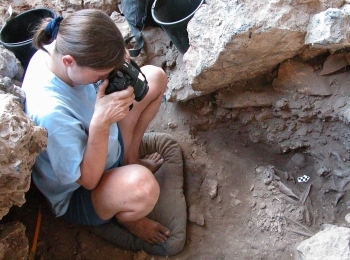The findings were discovered in the Snail Cave in the Western Galilee

An archaeologist from the Hebrew University uncovered in the Snail Cave in the Western Galilee evidence of feasts held by members of the Natufian culture on the occasion of a burial at the site 12,000 years ago. The remains of the feast, buried in a special pit, are the first evidence ever found of mass feasts held in the context of a burial.
Last year, the archaeological expedition led by Dr. Lior Grossman from the Institute of Archeology at the Hebrew University uncovered a 12-year-old skeleton of a woman who apparently engaged in shamanism (spiritual activity) in the Lower Snail Cave. This year, the excavation team led by her uncovered a pit that was used as a garbage can for the leftover food from a meat feast that was held there, probably as part of the funeral procession.
In an article published in August in the prestigious journal Proceedings of the National Academy of Sciences, the researchers, Dr. Natalie Monroe and Dr. Lior Grossman, describe the analysis of the findings found in the pit, including beef bones from at least 3 cows. In the roof of the pit, the walls of which were supported by stones and rock, a woman's skeleton was buried on top of which the Nepotim placed a gravestone. The large number of bones of the cow skeletons found in the pit shows that it is an amount of meat of at least 300 kilos, an amount that was enough for one multi-participant meal.
"The fallen actually left their special garbage can, and they also did it in the area of graves," notes Dr. Grossman. According to her, the remains of the meal found in the snail cave survived for thousands of years thanks to the hole that the Natufian culture dug in the ground specifically for their burial.
In addition to the remains of food found in the pit, 71 shells and shells of turtles were also found in the shaman's tomb. An analysis of the remains by the researchers revealed that the turtles had their bellies split open, the turtle's body was removed and its shell was used as a bowl in which the turtle was roasted. The burn marks on the turtle shells indicate that the turtles were saved together with the shell and hence were also used for food. According to the researchers, the turtles were enough for a meal for at least 35 people.
The Natufian culture existed between 15,000 and 11,500 BC, at a time when human society began the transition to permanent settlement and towards food production and agriculture. This economic change and the increase in the size of the population required a new social organization that led to a cultural revolution. This transition also resulted in the development of new social mechanisms aimed at relieving pressures and tensions between group members by creating shared traditions and rituals. In this context, the researchers claim, the feast is part of a ritual act that took place around the burial event. "During this period, relationships between individuals in large companies began to be institutionalized, beyond family units, and for this purpose, special events such as funeral feasts were held," explains Dr. Grossman.
During the excavations in the cave, which have been ongoing since 1995, graves of 28 people from the Natufian culture were found. 26 of them were buried in three shared pits, in a separate grave the shaman was buried and in the other grave was found the skeleton with the remains of the meal underneath. The location of the cave on top of a cliff and in the heart of the area of the existence of the Natufian culture indicates the importance of the site and the importance of the burial.

3 תגובות
What's new? Just like the festivities that take place today in the Galilee. (Could the deceased have died many years before?)
It is interesting how they rule out the possibility that those people simply got rid of waste in the same place where they buried their dead. Is there a separate garbage site in the area? Why isn't it assumed that all the leftovers are from the same source, from one meal?